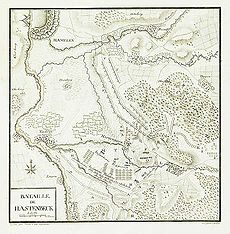Invasion of Hanover (1757)
| Invasion of Hanover | |||||||
|---|---|---|---|---|---|---|---|
 Battle of Hastenbeck |
|||||||
|
|||||||
| Belligerents | |||||||
|
|
|
||||||
| Commanders and leaders | |||||||
|
|
|
||||||
| Strength | |||||||
| Roughly 100,000 | |||||||
The Invasion of Hanover took place in 1757 during the Seven Years' War when a French army under Louis Charles César Le Tellier, duc d'Estrées advanced into the Electorate of Hanover and neighbouring German states following the Battle of Hastenbeck. French forces overran most of Hanover forcing the Hanoverian Army of Observation, intended to defend the Electorate, to Stade on the North Sea coast. At the Convention of Klosterzeven the Duke of Cumberland agreed to disband his army and acknowledge the French occupation of the Electorate.
Following pressure by his British ministers, George II of Great Britain, Elector of Hanover, renounced the Convention and the German troops returned to active operations. By spring 1758, under a new commander, the Allied forces had driven the French out of Hanover and pushed them back across the River Rhine.
Following the outbreak of the first fighting between Britain and France in North America in 1754, the French leadership saw that the limited population, troops and resources available in French Canada meant it would ultimately fall to the British if the war was prolonged, and decided to try and gain an equivalent in Europe to exchange for Canada at the negotiating table.
Since 1714 Britain and the Electorate of Hanover had shared a single monarch. George II was ruler of both states – and the French believed they could exert pressure on him as King of Great Britain by occupying Hanover. In response Britain initially planned to hire 50,000 Russian troops to defend Hanover but later altered the plan by making an alliance with Prussia and forming an Army of Observation composed of Hanoverian, Brunswick and Hessian troops mostly paid for by the British government. A number of British officers, such as Jeffrey Amherst and Guy Carleton, were given commands in the force. It was placed under the command of the Duke of Cumberland, second son of George II. The name Army of Observation expressed a hope that the army would serve as a deterrent and their role would merely be to observe. In early 1756, when a French invasion of the British Isles seemed imminent, many of the Hanoverian and Hessian troops were shipped to southern England to boost its defences. As the threat of invasion subsided, the troops were then shipped back to Germany again.
...
Wikipedia
